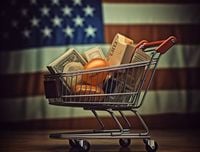The Federal Reserve's key inflation measure rose more than expected in February while consumer spending also posted a smaller than projected increase, the Commerce Department reported on Friday, March 28, 2025. The core personal consumption expenditures price index showed a 0.4% increase for the month, the biggest monthly gain since January 2024, putting the 12-month inflation rate at 2.8%. Economists surveyed by Dow Jones had been looking for respective numbers of 0.3% and 2.7%. Core inflation excludes volatile food and energy prices and is generally considered a better indicator of long-term inflation trends.
In the all-items measure, the price index rose 0.3% on the month and 2.5% from a year ago, both in line with forecasts. At the same time, the Bureau of Economic Analysis report showed that consumer spending accelerated 0.4% for the month, below the 0.5% forecast. That came as personal income posted a 0.8% rise, against the estimate for 0.4%. Stock market futures briefly moved lower following the release as did Treasury yields.
Federal Reserve officials focus on the PCE inflation reading as they consider it a broader measure that also adjusts for changes in consumer behavior and places less of an emphasis on housing than the Labor Department's consumer price index. Shelter costs have been one of the stickier elements of inflation and rose 0.3% in the PCE measure. "It looks like a 'wait-and-see' Fed still has more waiting to do," said Ellen Zentner, chief economic strategist at Morgan Stanley Wealth Management. "Today's higher-than-expected inflation reading wasn't exceptionally hot, but it isn't going to speed up the Fed's timeline for cutting interest rates, especially given the uncertainty surrounding tariffs."
Good prices increased 0.2%, led by recreational goods and vehicles, which increased 0.5%. Gasoline offset some of the increase, with the category falling by 0.8%. Services prices were up 0.4%. Households also grew more cautious with their money, as the personal saving rate increased to 4.6%, the highest since June 2024.
The report comes with markets on edge that President Donald Trump's tariff intentions will aggravate inflation at a time when the data was making slow but steady progress back to the Fed's 2% goal. After cutting rates a full percentage point in 2024, the central bank has been on hold this year, with officials of late expressing concern over the impact the import duties will have on prices. Economists tend to consider tariffs as one-off events that don't feed through to longer-lasting inflation pressures, but the encompassing scope of Trump's tariffs and the potential for an aggressive global trade war are changing the stakes.
According to Commerce Department data released on March 28, 2025, annual inflation was 2.8% last month, according to the core personal consumption expenditures (PCE) index, the Fed’s preferred measure of inflation as it excludes price changes in the more volatile food and energy categories. Economists expected core PCE inflation of 2.7%, according to median forecasts tracked by FactSet, while Fed Chairman Jerome Powell said last week the U.S. central bank anticipated a 2.8% year-over-year increase. Core PCE inflation is still far above central bankers’ target of 2%, a threshold it has not met since February 2021.
Overall PCE inflation was 2.5% in February, matching the Fed’s and consensus economists’ matching projections of 2.5%. The PCE index increased 0.3% from January to February and the core measure rose by 0.4%, adjusting for seasonality, compared to economist forecasts of a 0.3% month-over-month increase. That’s a notable uptick, especially with the economic landscape shifting amid ongoing tariff discussions.
Big Number 4.6%. That’s the proportion of Americans’ disposable income they saved in February, according to the Commerce Department’s personal saving rate metric released Friday. The saving rate averaged 5.7% from the turn of the millennium through January. Fed staff expect core PCE inflation to come in at 2.8% by December, according to median quarterly economic projections released last week, up from a 2.5% forecast last quarter for the end of 2025 and a 2.2% projection a year ago. A “good part” of the higher inflation expectations comes from tariffs, Powell noted last week.
Core PCE inflation peaked at a four-decade high of more than 5% in 2022, as prices surged globally due to various inflationary pressures peaking simultaneously, including COVID-19 related supply chain issues and soaring energy prices following Russia’s invasion of Ukraine. Other than the most glaring consequence of bringing higher everyday price tags for consumers, sticky inflation has also had the undesirable effect of keeping interest rates higher, as the Fed typically keeps borrowing costs elevated as a method to cool inflation.
The Fed has yet to declare victory on inflation and has kept the federal funds rate steady at 4.25% to 4.5% since December, higher than it ever stood from 2008 to 2022. This steady approach reflects a cautious stance amid the evolving economic landscape. Analysts expect the headline PCE rate to stay at 2.5% year-over-year, while core inflation is forecast to edge up to 2.7% from 2.6%. There’s also talk of a 0.4% monthly gain in core inflation.
As the economic outlook remains uncertain, with spending expected to rise 0.7% and incomes up 0.4%, the Fed may not see enough weakness to justify cutting rates anytime soon. The Trump administration’s tariff plans are adding new layers to the inflation picture. Boston Fed’s Susan Collins indicates a short-term spike is likely, while St. Louis Fed’s Alberto Musalem isn’t so sure it’ll fade quickly. His team estimates the tariffs could lift inflation by over a full percentage point.
Consumer sentiment likely dropped sharply in March, and inflation expectations likely rose to their highest level in over a year. This could lead households to cut back on spending, which would weigh on growth and make the Fed’s job even harder. Even if today’s number doesn’t shock, traders will stay focused on the bigger picture: inflation risks tied to tariffs, weak sentiment, and Fed hesitation.
In summary, the latest PCE inflation report reveals a complex economic landscape where inflation remains a pressing concern. The Federal Reserve's cautious approach reflects the uncertainty surrounding tariffs and their potential impact on consumer prices. With personal saving rates rising, households appear to be exercising caution in their spending habits, adding another layer to the Fed's challenges in navigating the current economic environment.






